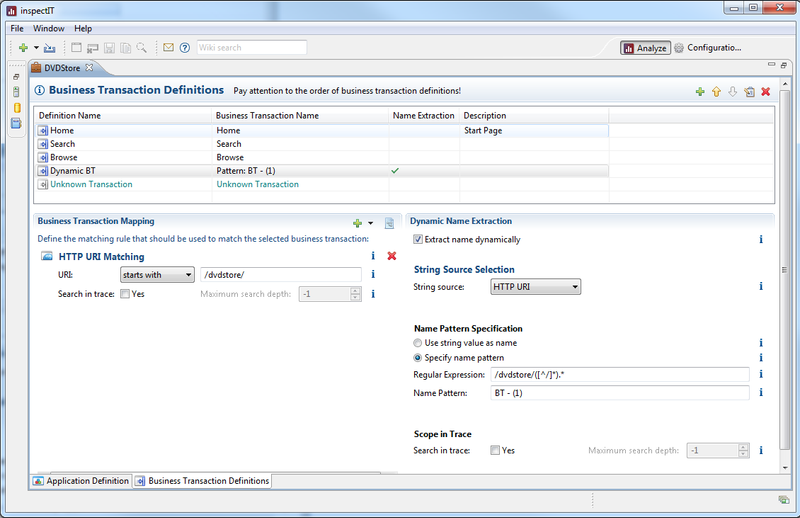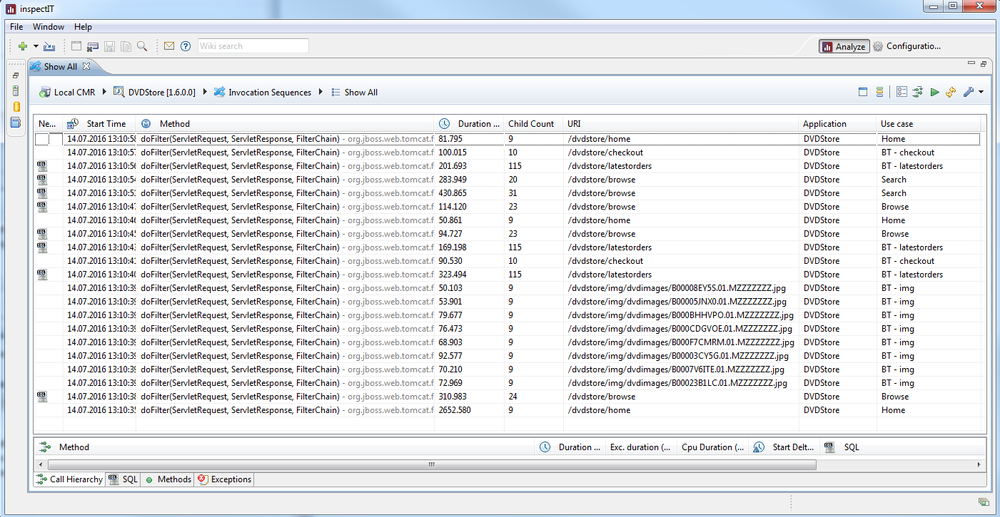 Business Transaction Definitions page of an application definition editor. To navigate there, open the target application and select the
Business Transaction Definitions page of an application definition editor. To navigate there, open the target application and select the  Business Transaction Definitions tab at the bottom of the editor:
Business Transaction Definitions tab at the bottom of the editor:
Before being able to define business transactions a corresponding application must have been defined which the business transaction should belong to. The page Defining Applications describes how to create application definitions.
Business transaction definitions are managed on the  Business Transaction Definitions page of an application definition editor. To navigate there, open the target application and select the
Business Transaction Definitions page of an application definition editor. To navigate there, open the target application and select the  Business Transaction Definitions tab at the bottom of the editor:
Business Transaction Definitions tab at the bottom of the editor:

Each application may have an arbitrary amount of business transaction definitions. Per default, each application definition has an immutable business transaction called  Unknown Transaction. The Unknown Transaction is a placeholder for the case that none of the defined business transaction mappings apply to an incoming request.
Unknown Transaction. The Unknown Transaction is a placeholder for the case that none of the defined business transaction mappings apply to an incoming request.

To create a business transaction definition click on the  Create button in the toolbar of the
Create button in the toolbar of the  Business Transaction Definitions page. This opens a dialog requesting for the following information:
Business Transaction Definitions page. This opens a dialog requesting for the following information:

A created business transaction definition appears in the upper table. Analogously to applications, business transactions definitions are evaluated in the order as displayed in that table. When selecting a business transaction definition, in the lower half of the page two additional sections appear:

The order of business transaction definitions in the table plays an important role, if business transactions are not strictly separated.
When requests are evaluated to find the business transaction they should be assigned to, the business transaction definitions are processed in the same order as shown in the table. If the evaluation identifies a matching business transaction for a request, all subsequent business transaction definitions are not considered anymore for the corresponding request. This is not a problem if the matching rules of the differnet business transaction definitions are unabiguous. However, if this is not the case and the rules of one business transaction definition cover the rules of another business transaction definition, then the order of business transaction definitions is important.
Position business transaction definitions with rather generic rules below business transaction definitions with rather specific rules! |
Lets assume we have two business transaction definitions in the following order and having following matching rules


If the matching rules are specified as shown in the screenshots above, then the Browse business transaction is more generic than Search. In particular, any request matching Search would also match Browse. And since Browse is before Search, all (Browse and Search-requests) will be assigned to the Browse business transaction.
To correct this, Search needs to be moved above Browse as it is more specific than browse. To move business transaction definitions use the up and


Apart from assigning static business transaction names to user requests (by means of matching rules), inspectIT provides the possibility to extract business transacation names dynamically from measurement data. To activate dynamic name extraction just enable the checkbox "Extract name dynamically" in the Dynamic Name Extraction section.
During evaluation of requests the dynamic name extraction is only applied if the left-hand side rules (Business Transaction Mapping section) match the request. |
The dynamic name extraction configuration provides the following properties:
If the dynamic name extraction cannot be applied within the specified scope in the call tree of the request, then the corresponding request is marked with a generic business transaction name ("<Name Pattern> (unmapped)").

In the above example the business transaction name is extracted from the HTTP URI. In particular, the first path section after "/dvdstore/" is used as a fragment. This fragment is then used in the name pattern by referencing the first extraction group "... (1)".
Once the business transactions are defined, they are displayed in the Invocation Sequence view. In the example below we see the static definitions (Home, Browse and Search) as well as the dynamically extracted business transactions (BT - XXXXX):
